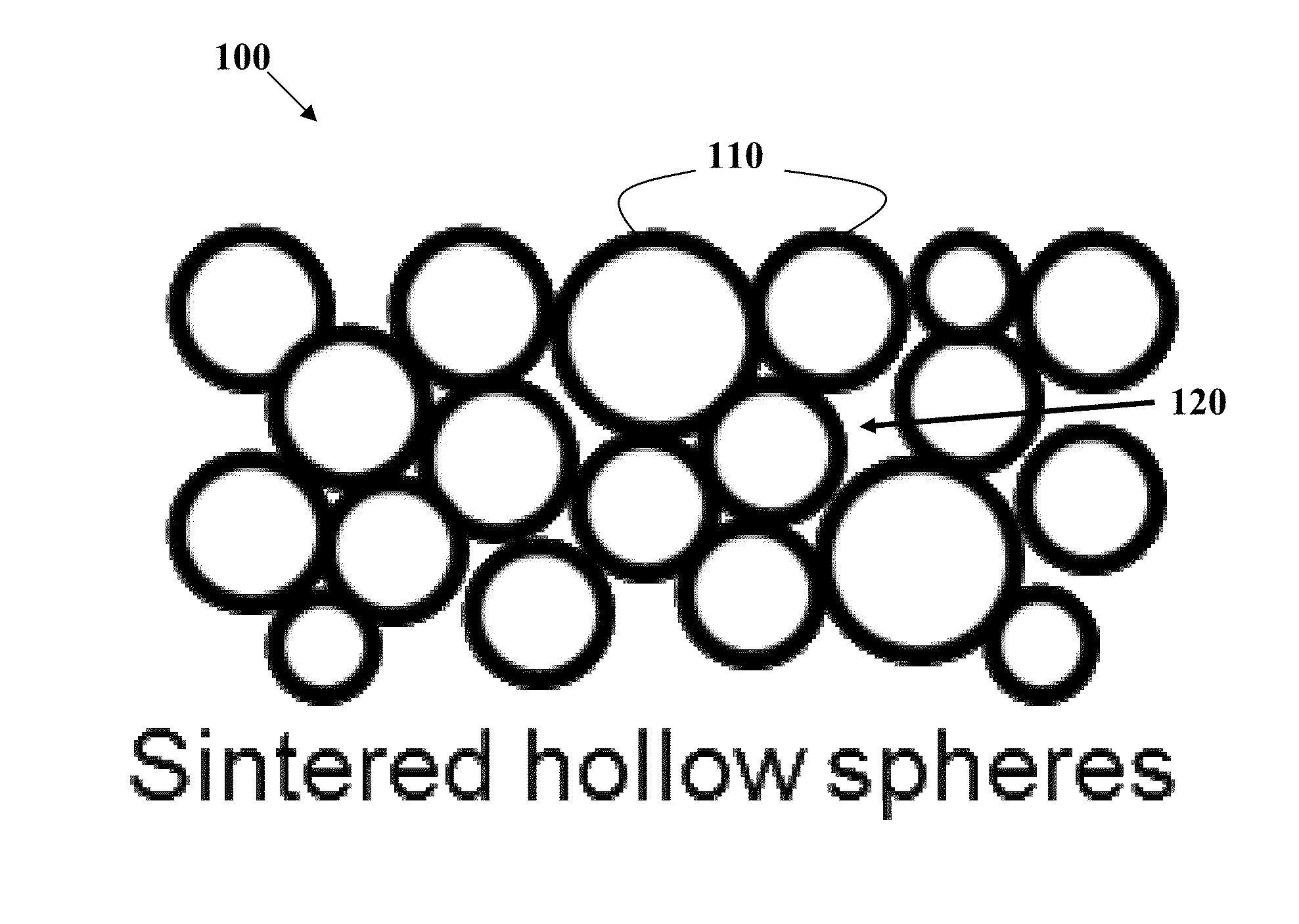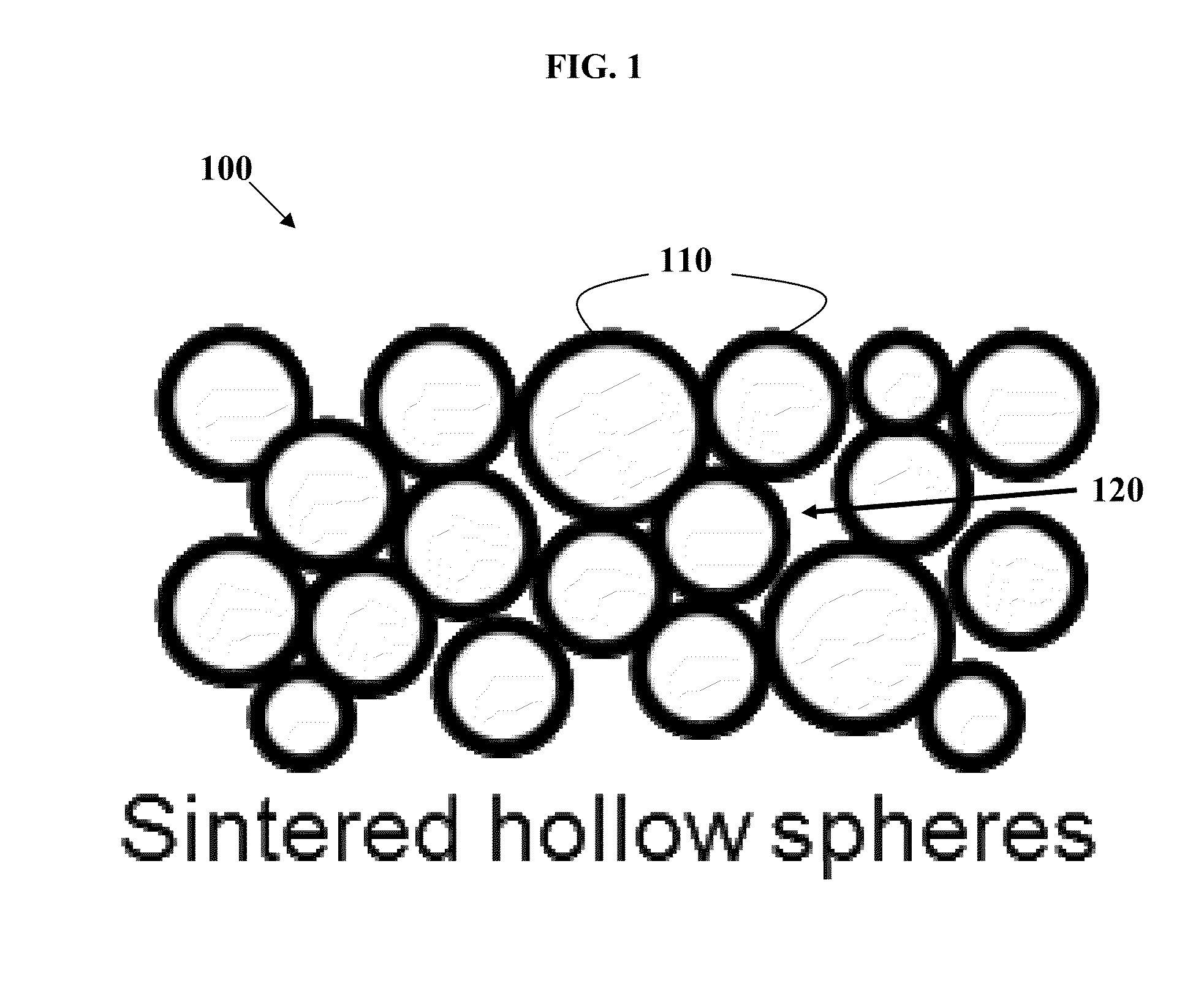Thermal barrier materials and coatings with low heat capacity and low thermal conductivity
a technology of thermal conductivity and thermal conductivity, applied in the direction of climate sustainability, synthetic resin layered products, machines/engines, etc., can solve the problems of low damage tolerance, low heat capacity, and achieve low damage tolerance and low thermal conductivity
- Summary
- Abstract
- Description
- Claims
- Application Information
AI Technical Summary
Benefits of technology
Problems solved by technology
Method used
Image
Examples
example 1
Sintered Inconel Spheres
[0146]One example of this invention is a material comprising sintered hollow nickel alloy (Inconel 718) spheres with a diameter of 50 microns and a wall thickness of 1.0 micron, with a diameter to wall thickness ratio of 50. This microstructure (as depicted in FIG. 1) exhibits a calculated thermal conductivity of 0.12 W / m·K and heat capacity of 290 kJ / m3·K. The thermal conductivity and heat capacity are calculated (not considering radiation and convection) according to Solórzano et al., “Thermal Properties of Hollow Spheres,”Multifunctional Metallic Hollow Sphere Struct., pp. 89-107 (2009) which is incorporated by reference herein. For Inconel 718, a thermal conductivity of 11 W / m·K and heat capacity of 3900 kJ / m3·K is used in estimating the thermal conductivity and heat capacity of sintered spheres. For comparison, conventional zirconia-based thermal barrier coatings used in the aviation industry have thermal conductivities around 0.8 W / m·K and heat capaciti...
example 2
Sintered Hollow Glass Spheres
[0149]FIGS. 4-7 are collectively a schematic flowchart of sintered hollow spheres material fabrication. Hollow glass spheres (silica, soda-lime, borosilicate, aluminosilicate, etc.) 410 are fused into a thin layer 420 by heating 430 above the glass transition temperature (FIG. 4), creating a closed-cell structure with high porosity similar to the schematic in FIG. 1. Spheres 510 are fused to adjacent spheres at flattened points of contact, leaving open space 520 between the spheres, as well as space 530 inside them (FIG. 5). The resulting structure has a large (>60%) open volume fraction, creating a material with low heat capacity and low thermal conductivity and relatively high crush strength. The properties can be tailored by selecting hollow spheres with different diameter and wall thickness.
[0150]A ductile, corrosion-resistant and oxidation-resistant cover layer 620 is added by induction melting of a thin nickel sheet onto the top surface of the poro...
example 3
Flotation Co-deposition of Hollow Glass Spheres in a Nickel Matrix
[0152]Hollow glass spheres are incorporated into a nickel matrix at a high volume fraction through flotation co-deposition. A commercial nickel sulfamate plating solution is used to electrodeposit the nickel. A schematic of the flotation co-deposition process setup is shown in FIG. 9. Hollow glass spheres 910 are added directly to 300 mL of plating solution 920 at a concentration of 3 g / L. The mixture is stirred continuously and heated to 65° C. After reaching temperature, the majority of the added hollow glass spheres 910 have floated to the top. A copper cathode 930 is prepared by degreasing (alcohol) and acid activation (10% sulfamic acid). The cathode is immersed just below the surface of the floating glass spheres 910 and a current equivalent to 10 mA / cm2 is applied for 2 hours (anode 940).
[0153]While plating, the solution is periodically stirred by hand at the surface to replenish solution at the interface and f...
PUM
| Property | Measurement | Unit |
|---|---|---|
| Temperature | aaaaa | aaaaa |
| Fraction | aaaaa | aaaaa |
| Fraction | aaaaa | aaaaa |
Abstract
Description
Claims
Application Information
 Login to View More
Login to View More - R&D
- Intellectual Property
- Life Sciences
- Materials
- Tech Scout
- Unparalleled Data Quality
- Higher Quality Content
- 60% Fewer Hallucinations
Browse by: Latest US Patents, China's latest patents, Technical Efficacy Thesaurus, Application Domain, Technology Topic, Popular Technical Reports.
© 2025 PatSnap. All rights reserved.Legal|Privacy policy|Modern Slavery Act Transparency Statement|Sitemap|About US| Contact US: help@patsnap.com



